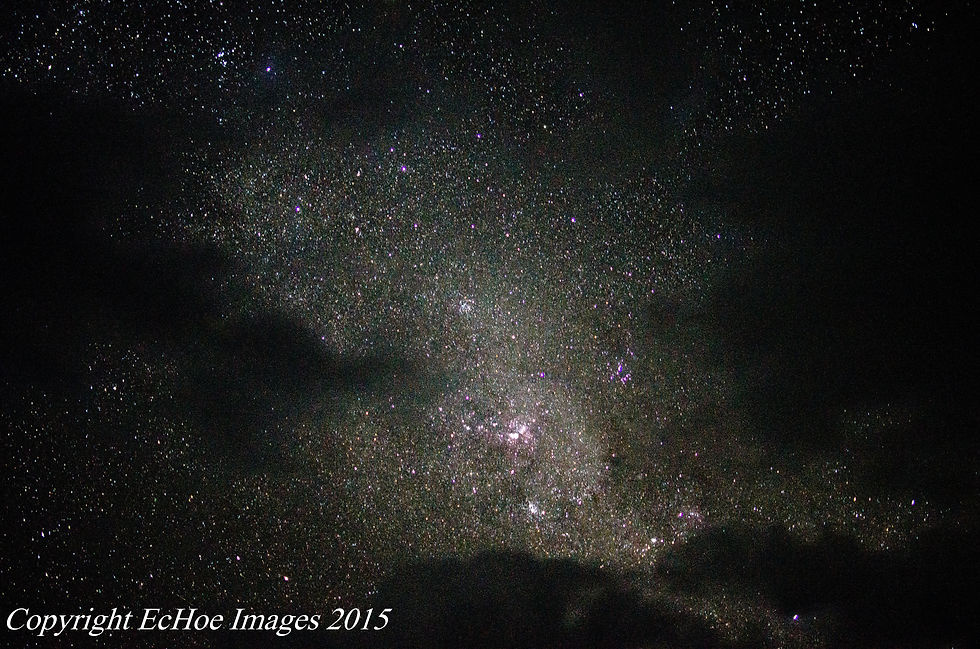
LANDSCAPES
In the Night Garden
LA LA Lunar
The South West Australian skies are at their most beautiful during winter but harder to see because of light pollution, cloud cover and winter storms. If you want to learn more about the creatures of the night, the constellations, aurora hunting and the milky way, you need to position yourself away from light pollution. Even the light from one street lamp can reduce your capacity to see at night.
As well as the daily turn of the planet, the Earth's annual orbit around the sun means we see slightly different sections of the universe every day. It also means we'll be back where we started in a year's time, looking at the same stretch of sky. As well as the Earth's position in space, the area of sky we can see at night is determined by how far north or south of the equator we are.
People in the Southern Hemisphere get an exclusive view of the Large and Small Magellanic Clouds — two of our neighbouring galaxies that can identified with the naked eye — and some of the brightest globular clusters — spherical clumps of stars that orbit galaxies — such as Omega Centauri in the constellation Centaurus and 47 Tucanae, in the constellation Tucanae (the Toucan).
Dark sky features such as dark nebulae — clouds of interstellar dust from stars that exploded long ago that obscure light from the stars behind them — are also more prominent in the Southern Hemisphere. The darkest of the dark nebulae is a feature called the Coalsack. Tucked in near the Southern Cross, the Coalsack forms the head of our best known Indigenous constellation, the Emu in the Sky.

Light pollution in the city and towns often reduces the capacity to see the night sky, in country areas, the view is magnificent.

Through the Karri tree canopy the amazing milky way.

Through the Karri tree canopy the amazing milky way.

Through the Karri tree canopy the amazing milky way.

The sunrise over Mangles Bay, Point Peron, Rockingham.

The sunrise as the moon sets in the west at the Rivermouth Margaret River.

The Margaret River at night with the moon drenching the earth in light.

As the moon lights up the sky the river must end.

Full moon setting on a new day.

No luck with an aurora, however the beach at Gas Bay was a delight.

Late in the evening at the River Mouth in Margaret River, there are not as many families enjoying the stars but backpacker galore in the carpark.

The setting of the full moon in the west as the sun rises in the east.

So many stars so little time to admire them.

Full moon setting in the West.

More than a million, trillion bazillion stars in the night sky sparkling for me and for you.

The ocean laps at the most frequented beach in the night when no one is looking.

Stars sparkling for the observer of the evening.

The Blackwood River and the fireworks are very good companions.

The Blackwood River and the fireworks are very good companions.

The Blackwood River and the fireworks are very good companions.

The Blackwood River and the fireworks are very good companions.

The Blackwood River and the fireworks are very good companions.

The Blackwood River and the fireworks are very good companions.

The Blackwood River and the fireworks are very good companions.

The Blackwood River and the fireworks are very good companions.

The Blackwood River and the fireworks are very good companions.

The Blackwood River and the fireworks are very good companions.

The Blackwood River and the fireworks are very good companions.

The Blackwood River and the fireworks are very good companions.

The Blackwood River and the fireworks are very good companions.

The Blackwood River and the fireworks are very good companions.

A dark and stormy night can't stop the aurora hunters, however rain does make us hesitate.

Bird watching under the full moon as it escapes the sunrise.

Bests view of the city is at night.

Through the branches of the tree of life, comes light in the night.

Dance like no one is watching.

My first aurora chase ended with this fantastic colour and exceptional view of the Leeuwin Lighthouse, Cape Leeuwin where two oceans meet.

Full moons and memories, eerie light and luminescence at the War Memorial in Kings Park.

Full moons and memories, eerie light and luminescence at the War Memorial in Kings Park.